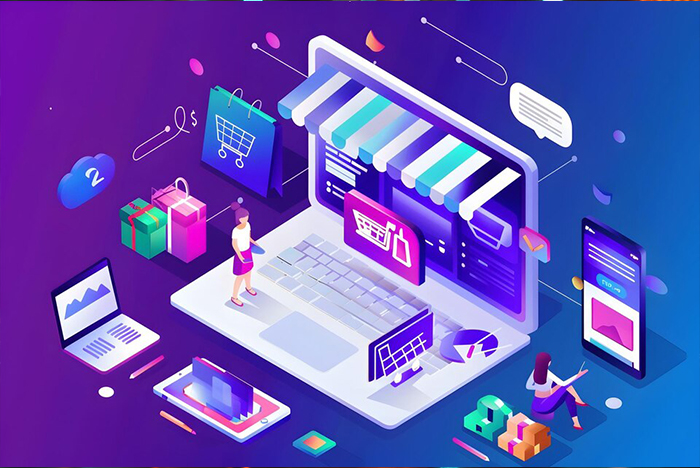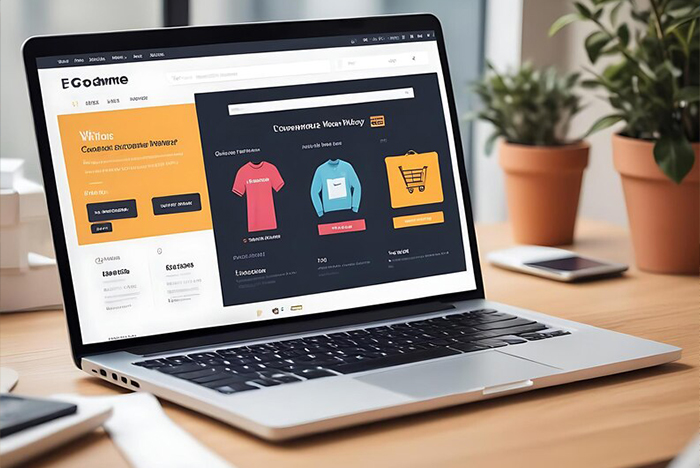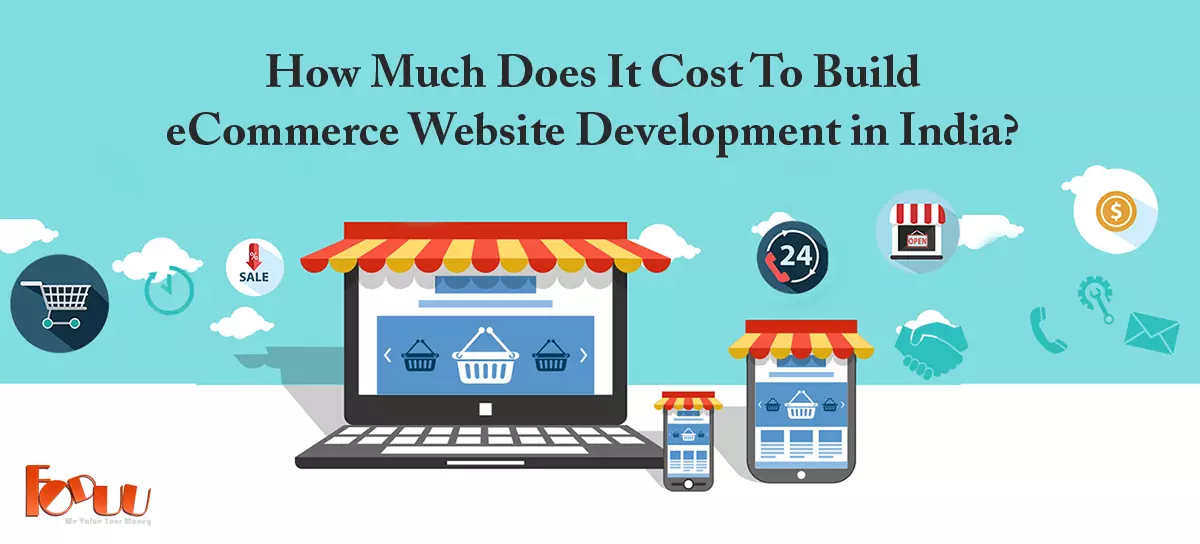Do you want to build an e-commerce website but aren't sure how much it would cost you in India?
The good news is that a completely working, SEO-friendly, and responsive e-commerce website can be built in India for as little as $299.
This blog post is for you if you've already decided to employ Indian e-commerce developers to design your online store but are still curious about the cost of developing an e-commerce website.
In this blog post, we'll discuss some of the numerous elements that influence the cost of an e-commerce website in India.
CMS Ecommerce Package
Custom Ecommerce Package
What is an ECommerce Website?

An ecommerce website is an online platform that facilitates the buying and selling of goods and services over the Internet. It serves as a virtual marketplace where businesses showcase their products or services, and consumers browse, select, and purchase items from the comfort of their own homes or wherever they have internet access. Ecommerce websites typically feature a user-friendly interface that allows customers to search for products, view product details, add items to a virtual shopping cart, and complete transactions securely through integrated payment gateways.
The concept of ecommerce has revolutionized the way businesses operate and consumers shop, offering unprecedented convenience and accessibility. Unlike traditional brick and mortar stores, ecommerce websites are accessible 24/7, enabling consumers to shop at their convenience without being restricted by store hours or geographical limitations. This flexibility appeals to modern consumers who lead busy lives and value convenience above all else.
Apart from this, there are different key components available for e-commerce, which include:
1. Online Storefront
Description : An online storefront is like the interface for your customers to browse and make a purchase. It consists of, product listings and category search facilities.
Components:
- Product pages
- Categories and filters
- Search bar
- Shopping cart
- Checkout process
2. PIM (Product Information Management)
In a nutshell, PIM is the master of product data and information, delivering this accurate and comprehensive data across every single sales channel in which products are listed.
Components:
- Product descriptions
- Specifications
- Images and videos
- Pricing information
3. Order Management System (OMS)
Description: OMS handles order processing from checkout to fulfillment, including inventory management, order tracking, and returns.
Components:
- Order tracking
- Inventory control
- Shipping management
- Return and refund handling
4. Payment Gateway
The payment gateway, like other components, is also important, as through this all the payments are analyzed, & this will help in providing the proper detail to both parties, like the sender or store owner, about the exact status of the product. This way there won’t be any third party required to perform any task as both parties will manage the transfer of money on their own to have a satisfying experience.
Components:
- Secure payment processing (credit/debit cards, digital wallets)
- Encryption and fraud prevention
- Multiple payment methods (PayPal, Stripe, etc.)
5. Content Management System (CMS)
The role of CMS is to manage & update the content on interactive parts of the website, including blogs, home, & many more.This will help them in engaging a more organic audience for the platform, which will increase their product sales as they will get to try at least once to come to any decision or conclusion.
Components:
- Content creation and editing tools
- Media management (images, videos)
- Blogging and product updates
- SEO optimization
6. Customer Relationship Management (CRM)
CRM is the component that manages all the interactions that mainly occur between customers & other providers. It’s because this way the data would be managed as per that & user will get to build a good interest with that specific platform to continue their purchase.
Components:
- Customer profiles and data
- Customer support systems
- Communication tools (email, live chat)
- Loyalty programs and marketing automation
7. Logistics and Fulfillment
This component helps in managing the storage, packing, and shipping of products to customers. Through this, they will make sure that everyone will have a satisfying experience.
Components:
- Warehousing and inventory management
- Packaging and shipping
- Delivery tracking and updates
- Returns processing
eCommerce Scope in India:
E-commerce in India has witnessed significant growth in recent years, driven by factors such as increasing internet penetration, smartphone adoption, and a young, tech-savvy population. The Indian e-commerce market is expected to continue its expansion, offering numerous opportunities for businesses and investors alike. Here are some key aspects of the e-commerce scope in India:
1. Growing Consumer Base: With over 600 million internet users and a population of 1.3 billion, India has a massive consumer base for e-commerce. The number of online shoppers in India is projected to reach 220 million by 2025, presenting a vast opportunity for e-commerce businesses.
2. Mobile Commerce (m-commerce): India is one of the world's largest mobile markets, with a high percentage of smartphone users. M-commerce has become increasingly popular, with many consumers preferring to shop via their mobile devices. This trend is expected to continue, making mobile optimization crucial for e-commerce players in India.
3. Online Marketplaces: Online marketplaces like Amazon India, Flipkart, and Snapdeal dominate the Indian e-commerce landscape. These platforms provide a wide range of products and services, making it convenient for customers to shop online. Marketplaces also offer a platform for small and medium-sized enterprises (SMEs) to reach a larger audience.
4. Booming Categories: Key e-commerce categories in India include fashion, electronics, and grocery. Fashion e-commerce is expected to grow at a rapid pace due to increasing disposable incomes and the desire for trendy, affordable clothing. Electronics and appliances are also popular, with consumers seeking deals and convenience. The emergence of online grocery shopping has also gained traction in recent years, offering a convenient solution for busy urban consumers.
5. Digital Payments and Wallets: The Indian government's push for digital transactions and the introduction of initiatives like the Unified Payments Interface (UPI) have significantly boosted the adoption of digital payment methods. This has made online shopping more accessible and secure for Indian consumers, further fueling e-commerce growth.
6. Logistics and Delivery Infrastructure: The Indian e-commerce industry has seen significant improvements in logistics and delivery infrastructure, enabling faster and more reliable shipping across the country. This has helped to address one of the major challenges faced by e-commerce businesses in India – timely and efficient delivery of products.
7. Government Initiatives: The Indian government has taken several steps to promote e-commerce growth, such as easing foreign direct investment (FDI) norms, providing incentives for startups, and implementing policies to boost digital infrastructure. These initiatives have contributed to a more favorable business environment for e-commerce players in India.
8. Challenges and Opportunities for SMEs: While e-commerce giants dominate the market, SMEs also have opportunities to grow their businesses online. E-commerce platforms provide a level playing field for SMEs to reach a wider audience, but they must focus on building their online presence, optimizing their product listings, and offering competitive prices and services.
Types of ECommerce Business Models:

Ecommerce business models define the structure and operations of online businesses, outlining how they generate revenue and interact with customers. There are several types of ecommerce business models, each with its unique characteristics and strategies. Here are some common types:
1. Business to Consumer (B2C):
In the B2C model, businesses sell products or services directly to individual consumers.
Examples include online retail stores like Amazon, Flipkart, and eBay, where consumers can purchase a wide range of products such as electronics, clothing, books, and more.
B2C businesses typically focus on building strong brand identities, offering competitive pricing, and providing a seamless shopping experience to attract and retain customers.
2. Business to Business (B2B):
B2B ecommerce involves transactions between businesses, where one business sells products or services to another business.
Examples include wholesale marketplaces, procurement platforms, and online marketplaces connecting manufacturers, suppliers, distributors, and retailers.
B2B ecommerce platforms often offer features such as bulk ordering, negotiated pricing, contract management, and integration with enterprise systems to streamline procurement processes for businesses.
3. Consumer to Consumer (C2C):
In the C2C model, individual consumers buy and sell products or services to other consumers through online marketplaces or platforms.
Examples include platforms like eBay, Craigslist, and Facebook Marketplace, where individuals can list items for sale and connect with potential buyers.
C2C ecommerce platforms facilitate peer-to-peer transactions, allowing individuals to monetize unused items, secondhand goods, handmade products, or services.
4. Consumer to Business (C2B):
C2B ecommerce involves transactions where individual consumers offer products or services to businesses.
Examples include freelancing platforms like Upwork and Fiverr, where individuals offer their skills and expertise to businesses seeking specific services.
C2B models may also include platforms where consumers provide user-generated content, product reviews, or feedback to businesses in exchange for compensation or rewards.
5. SubscriptionBased (SaaS):
Subscription-based ecommerce models operate on a recurring revenue model, where customers pay a subscription fee to access products or services regularly.
Examples include streaming services like Netflix and Spotify, subscription boxes for curated products like Birchbox and Blue Apron, and software as service (SaaS) platforms offering access to digital tools and resources.
Subscription based models focus on providing value through ongoing access to content, features, or experiences, often offering tiered pricing plans with varying levels of access and benefits.
6. Marketplace:
Marketplace ecommerce models bring together multiple sellers and buyers on a single platform, facilitating transactions between them.
Examples include platforms like Amazon Marketplace, Etsy, and Airbnb, where sellers can list their products or services, and customers can browse, compare, and purchase from various sellers.
Marketplace models typically generate revenue through transaction fees, commissions, subscription fees, or advertising fees charged to sellers or buyers.
7. Dropshipping:
Dropshipping ecommerce models involve selling products to customers without holding inventory or managing fulfillment.
In a dropshipping arrangement, the retailer (dropshipper) partners with suppliers or wholesalers who handle inventory storage, packaging, and shipping directly to customers.
Dropshipping businesses focus on marketing, customer service, and order management, leveraging supplier relationships to offer a wide range of products without the overhead costs of inventory management.
These are some of the primary ecommerce business models that have emerged in the digital era, each catering to different market segments, customer preferences, and industry dynamics. Businesses may adopt one or a combination of these models based on their products, target audience, competitive landscape, and strategic goals.
Advantages of ECommerce Website

Ecommerce websites offer numerous advantages for both businesses and consumers, contributing to the widespread adoption and growth of online retail. Here are some key advantages of ecommerce websites:
1. Global Reach:
Ecommerce websites have the potential to reach a global audience, breaking down geographical barriers and expanding market reach beyond local or regional boundaries.
Businesses can access customers from different countries and regions without the need for physical storefronts or international distribution channels.
2. Convenience:
Ecommerce offers unparalleled convenience for consumers, allowing them to shop anytime, anywhere, from the comfort of their homes or on the go.
Online shopping eliminates the need for physical travel to brick and mortar stores, saving time and effort for busy consumers with hectic schedules.
3. 24/7 Availability:
Ecommerce websites are accessible 24 hours a day, 7 days a week, providing customers with round the clock access to products and services.
Unlike traditional stores with fixed operating hours, ecommerce allows consumers to shop at their convenience, even outside regular business hours.
4. Expanded Product Selection:
Ecommerce websites offer a vast selection of products and services, far exceeding the inventory available in physical stores.
Consumers have access to a wide range of choices, with the ability to compare prices, features, and reviews from multiple sellers or brands.
5. Cost Savings:
Ecommerce eliminates many of the overhead costs associated with traditional retail, such as rent for physical storefronts, utilities, maintenance, and staffing.
Businesses can pass on these cost savings to customers through competitive pricing, discounts, promotions, and free shipping offers.
6. Personalization:
Ecommerce websites can leverage customer data and analytics to personalize the shopping experience for individual users.
Personalization features such as recommended products, tailored promotions, and targeted advertising help businesses engage customers more effectively and drive sales.
7. Streamlined Transactions:
Ecommerce websites streamline the purchasing process, allowing customers to browse, select, and purchase products with just a few clicks.
Integrated payment gateways enable secure online transactions using various payment methods, including credit/debit cards, digital wallets, net banking, and UPI.
8. Access to Customer Insights:
Ecommerce platforms capture valuable data on customer behavior, preferences, and purchase history, providing businesses with actionable insights for marketing and sales strategies.
Analytics tools track key metrics such as website traffic, conversion rates, average order value, and customer demographics, helping businesses optimize their online presence and drive growth.
9. Scalability:
Ecommerce platforms are highly scalable, allowing businesses to expand their product offerings, accommodate increasing traffic volumes, and adapt to changing market demands.
Businesses can easily add new products, update content, and implement new features or functionalities to meet evolving customer needs and stay competitive in the market.
10. Accessibility:
Ecommerce websites are accessible to a wide range of consumers, including those with mobility limitations, disabilities, or busy lifestyles.
Features such as adjustable font sizes, screen readers, and voice search options enhance accessibility and usability for all users, fostering inclusivity and diversity in online shopping experiences.
These advantages demonstrate the transformative impact of ecommerce on the retail industry, empowering businesses to reach new audiences, drive sales, and enhance customer satisfaction in today's digital economy.
Importance Of Ecommerce Websites:

Ecommerce websites have become indispensable for businesses in the modern era due to their significant impact on various aspects of operations and growth. Firstly, ecommerce websites provide businesses with a platform to reach a global audience, breaking geographical barriers and expanding market reach beyond traditional boundaries.
This global accessibility opens up new avenues for sales and revenue generation, allowing businesses to tap into diverse markets and customer segments. Additionally, ecommerce websites offer unparalleled convenience and accessibility for consumers, enabling them to shop anytime, anywhere, from the comfort of their homes or on the go. This convenience enhances customer satisfaction and loyalty, driving repeat purchases and long-term relationships.
Moreover, ecommerce websites streamline operations and reduce overhead costs associated with traditional retail, leading to improved efficiency and profitability. By leveraging data-driven insights and personalization techniques, businesses can enhance the shopping experience, engage customers effectively, and drive sales growth.
Overall, ecommerce websites play a crucial role in driving business success by facilitating global reach, enhancing customer experiences, and driving operational efficiency in today's digital economy.
Features An Ecommerce Website Must Have In 2024

As technology evolves and consumer expectations continue to rise, ecommerce websites must stay ahead of the curve by incorporating advanced features to enhance user experience and drive sales. Here are some essential features that ecommerce websites should have in 2024:
1. Voice Commerce Integration:
With the increasing popularity of voice assistants like Alexa and Google Assistant, ecommerce websites should integrate voice commerce capabilities. This allows users to search for products, add items to their carts, and complete purchases using voice commands.
2. Augmented Reality (AR) Product Visualization:
AR technology enables users to visualize products in their real-world environment before making a purchase. By implementing AR features, ecommerce websites can provide an immersive shopping experience, allowing users to interact with products virtually and make more informed buying decisions.
3. AI Powered Product Recommendations:
Leveraging artificial intelligence (AI) algorithms, ecommerce websites can offer personalized product recommendations based on user behavior, preferences, and past purchases. AI-powered recommendation engines enhance user engagement and increase conversion rates by showcasing relevant products to each individual user.
4. Dynamic Pricing and Personalized Discounts:
Dynamic pricing algorithms analyze market trends, competitor pricing, and user data to adjust product prices in realtime. Additionally, ecommerce websites can offer personalized discounts and promotions tailored to each user's shopping history and behavior, incentivizing purchases and increasing customer loyalty.
5. Progressive Web App (PWA) Support:
PWAs combine the best features of websites and mobile apps, offering fast loading times, offline access, and push notifications. Ecommerce websites should prioritize PWA development to provide users with a seamless and engaging shopping experience across devices.
6. One Click Checkout:
Streamlining the checkout process with one-click checkout options reduces friction and simplifies the purchasing journey for users. By storing payment and shipping information securely, ecommerce websites enable users to complete transactions quickly and efficiently.
7. Social Commerce Integration:
Integrating social commerce features allows users to discover and purchase products directly within social media platforms. Ecommerce websites should leverage social media channels such as Instagram, Facebook, and TikTok to showcase products, engage with customers, and drive sales.
8. Cryptocurrency Payments:
With the growing acceptance of cryptocurrencies like Bitcoin and Ethereum, ecommerce websites should support cryptocurrency payments to cater to tech savvy users and expand payment options. Integrating cryptocurrency payment gateways enables secure and decentralized transactions.
9. Subscription Services and Membership Programs:
Offering subscription based services and membership programs can drive recurring revenue and customer loyalty. Ecommerce websites can provide subscription options for products like groceries, personal care items, and entertainment services, offering convenience and value to subscribers.
10. Enhanced Security Measures:
As cyber threats continue to evolve, ecommerce websites must prioritize security measures to protect user data and transactions. Implementing multifactor authentication, SSL encryption, and robust cybersecurity protocols instills trust and confidence in users.
11. Environmental Sustainability Initiatives:
In response to growing environmental concerns, ecommerce websites should incorporate sustainability initiatives such as eco-friendly packaging, carbon offset programs, and product lifecycle assessments. Demonstrating a commitment to sustainability can resonate with environmentally conscious consumers and drive brand loyalty.
By incorporating these advanced features and functionalities, ecommerce websites can stay relevant, attract new customers, and retain existing ones in the competitive landscape of 2024.
With amazing features, there are some important SEO features that e-commerce websites must have about which people have less idea. Let’s have a look at them:
1. SEO-Friendly URL Structure
This is the most important thing that a website must have: the URLs. These are the ones that need to be mentioned clearly, be descriptive, and include target keywords. Avoid complex and lengthy URLs with special characters. It’s because this way users will get convenient access to the website instead of losing interest due to the complex URL.
2. Meta Tags (Title and Description)
Meta titles and descriptions appear in search engine results and should contain relevant keywords that accurately describe the content of each page. It’s because meta tags help the user understand easily that they are visiting which page of the website & further result in easy navigation.
Components:
- Title Tag: Include the product name and primary keywords.
- Meta Description: Provide a brief, compelling summary of the page’s content to entice clicks.
3. Optimized Product Descriptions
Product pages should include unique, keyword-rich descriptions that provide valuable information about the product, including features, benefits, and usage. This needs to be done because then the user will get to have a quick idea about whether the product they are thinking of buying will be useful for them or not. And if it is, then how will that work to continue their purchase?
4. Mobile-Friendly Design
A responsive and mobile-optimized design ensures that your e-commerce website performs well on smartphones and tablets, providing a seamless shopping experience.
- Impact: Google prioritizes mobile-first indexing, meaning mobile-friendly sites rank higher in search engine results pages (SERPs).
Key Components Of Ecommerce Website Development

Developing a successful ecommerce website involves integrating several key components to ensure optimal performance, user experience, and functionality. Here are the essential components of ecommerce website development:
1. User Interface (UI) Design:
UI design focuses on creating an intuitive and visually appealing interface that enhances the user experience. This includes designing navigation menus, product pages, checkout flows, and other elements to make the website easy to use and visually engaging.
2. Backend Development:
Backend development involves building the serverside infrastructure and database architecture that powers the ecommerce website. This includes setting up databases, creating APIs, integrating third-party services, and implementing business logic to manage product inventory, process orders, and handle user authentication.
3. Content Management System (CMS):
A CMS enables website administrators to manage and update content, product listings, pricing, and other information without requiring technical expertise. Popular CMS platforms for ecommerce include WordPress with WooCommerce, Magento, Shopify, and Drupal Commerce.
4. Ecommerce Platform Integration:
Choosing the right ecommerce platform is crucial for building a scalable and feature-rich online store. Ecommerce platforms provide essential functionality such as product management, inventory tracking, payment processing, and order fulfillment. Integrating with a robust ecommerce platform streamlines development and ensures compatibility with industry standards and best practices.
5. Product Catalog Management:
Effective product catalog management is essential for organizing and presenting products in a structured and appealing manner. This includes creating product categories, adding product descriptions, images, pricing, and attributes, as well as implementing search and filtering functionality to help users find products easily.
6. Shopping Cart and Checkout Process:
The shopping cart and checkout process are critical components of ecommerce websites. The shopping cart allows users to add products, view their cart contents, and proceed to checkout. The checkout process should be streamlined and user-friendly, with options for guest checkout, multiple payment methods, and order confirmation.
7. Payment Gateway Integration:
Integrating secure payment gateways enables users to make online payments securely using credit/debit cards, digital wallets, net banking, or other payment methods. Payment gateway integration ensures that sensitive payment information is encrypted and transmitted securely during transactions.
8. Shipping and Logistics Integration:
Integrating with shipping carriers and logistics providers enables real-time shipping rate calculation, order tracking, and seamless order fulfillment. Shipping integration automates shipping label generation, package tracking, and delivery notifications, enhancing the overall customer experience.
9. Responsive Web Design (RWD):
Responsive web design ensures that the ecommerce website is accessible and usable across devices of varying screen sizes, including desktops, laptops, tablets, and smartphones. RWD optimizes layout, content, and functionality to provide a consistent and user friendly experience on any device.
10. Search Engine Optimization (SEO):
Implementing SEO best practices improves the visibility of the ecommerce website in search engine results, driving organic traffic and increasing the likelihood of attracting potential customers. SEO strategies include keyword research, on-page optimization, metadata optimization, and content marketing.
11. Analytics and Reporting:
Analytics and reporting tools provide valuable insights into website performance, user behavior, sales trends, and conversion rates. By analyzing key metrics and data, website administrators can make informed decisions to optimize marketing strategies, product offerings, and overall website performance.
12. Security Features:
Implementing robust security features is essential to protect user data, prevent fraud, and maintain trust and confidence in the ecommerce website. Security measures include SSL encryption, HTTPS protocol, firewall protection, regular security audits, and compliance with data protection regulations such as GDPR and PCIDSS.
Cost to Develop an E-Commerce Website

An can vary significantly depending on various factors such as the complexity of the site, design requirements, features, and the development team's location. Here's a breakdown of the main factors that influence the cost of e-commerce website development and an estimated range for each:
1. Design and Layout: The visual appeal and user experience of your e-commerce website play a crucial role in attracting and retaining customers. Custom designs can cost anywhere from $1,000 to $10,000 or more, depending on the complexity and the designer's experience.
2. Platform Selection: There are various e-commerce platforms available, such as Shopify, WooCommerce, Magento, or custom-built solutions. The cost of using a platform like Shopify starts at around $29/month, while custom-built solutions can range from $20,000 to $100,000 or more.
3. Website Functionality: The features and functionalities you require will impact the development cost. Basic e-commerce websites may start at $10,000, while more complex sites with advanced features like custom integrations, payment gateways, and inventory management systems can cost upwards of $50,000.
4. Custom Development: If you need a unique, custom-built solution, the cost can be significantly higher. Custom development can range from $50,000 to $200,000 or more, depending on the complexity and the development team's location.
5. Mobile Responsiveness: Ensuring your e-commerce website is mobile-friendly is essential, as many customers shop using their smartphones. This factor can add around $5,000 to $10,000 to the overall cost.
6. Content Creation: High-quality product images and descriptions are crucial for an e-commerce website. Hiring a professional photographer and copywriter can cost between $1,000 to $5,000 or more, depending on the number of products and the team's experience.
7. Ongoing Maintenance and Support: Regular updates, security measures, and bug fixes are necessary to keep your e-commerce website running smoothly. This can cost anywhere from $50 to $500 per month, depending on the level of support required.
8. Development Team Location: The cost of development can vary based on the developer's location. Hiring a team in North America or Europe may cost more than working with a team from Asia, Eastern Europe, or South America.
Ecommerce website cost in India can range from a few thousand dollars for a simple platform-based site to over $200,000 for a complex, custom-built solution. The final cost will depend on your specific requirements, the platform you choose, and the development team you work with. It's essential to carefully consider your needs and budget when planning your e-commerce website development project.
What Are the Benefits of Hiring Indian Web Developers?

Hiring Indian web design businesses is the ideal alternative for you if you want to develop an e-commerce store at a low cost.
Without a doubt, the Indian workforce is less expensive than that of industrialized countries around the world, and building an e-commerce website in India might save you thousands of dollars, but there is another incentive for global enterprises to select India for outsourcing web development projects. And web developers in India have had similar experiences.
Yes, the majority of Indian web development firms use skilled e-commerce web developers. India has become the #1 choice for all organizations globally to outsource their web development projects due to its experienced and economical personnel to design e-commerce websites.
The exact cost is determined by a variety of factors, including your set sales and traffic goals, unique features selected, and the type of eCommerce business you operate.
How Much Does an Ecommerce Website Cost to Develop?

Design-You can choose between a fixed template and a bespoke design. The price differs significantly among them.
Custom functionality aspects and distinctive programme features will drive up the price.
Data Import - If you need product data or previous order/customer data imported, your website development prices will go up. Make sure you have all of the data you'll need to run the website.
SEO — It goes without saying that investing in a full-fledged digital marketing and ecommerce SEO strategy will raise the price of your eCommerce website development.
Integrating a website with an ERP system or any other third-party system can be very expensive.
Responsive Design – The level of mobile design customization needs can add to development time.
Website Development Business — If you hire an experienced and well-known website development company in India, you may have to pay more for the job.
Other costs include:
- Website maintenance and platform update costs
- Professional product photo shoot and content costs
- Marketing and advertising costs
Cms Based E-Commerce Website Cost In India

Typically, a simple or basic e-commerce website cost varies between $299 to $699 in which you can get:
- Domain name (for one year)
- Web hosting (for one year)
- Template design (with some customizations)
- E-Commerce features setup using open source CMS like WordPress
- Logo design
- Paypal payment gateway integration
- Flat shipping rate
- CMS to manage web pages
- Responsive e-commerce web design
- Option to generate coupons
Custom E-Commerce Website Cost In India

The average cost to create an e-commerce website with advanced features like below cost $1999 onwards upto $6800
- Domain name (for one year)
- Web hosting (for one year)
- Unique/custom website design
- E-Commerce features setup using open sources like wordpress other PHP frameworks
- Your choice of payment gateways like Paypal, etc.
- Logo design
- Advanced shipping pricing system which could be based on countries, product weight, product size, product quantity, order value or number of products.
- Advanced pricing system like different pricing system for different customers or may be customized pricing structure based on different product attributes such as weight, color, size etc.
- Choice of responsive web design (RWD) or adaptive web design (AWD)
- Integrated SEO features to help website achieve higher rankings on search engines such as Google
- Integrated Social Media features to help website content distribution among various social media platforms such as Facebook, Twitter etc.
E-Commerce Website Cost Is Also Affected By:

#1 Open Source
Choosing an open-source CMS and framework for your e-commerce website is a critical decision that has an impact on the overall cost of the project.
When compared to framework customization, using Open Source platforms like WordPress for your e-commerce web development might save you money.
#2 Website Hosting
If your e-commerce website pricing does not include web hosting, you are free to choose any of the best and most dependable web hosting companies based on your budget.
One of the most crucial things to look for when choosing a web server business to host your e-commerce store is scalability.
Another factor that e-commerce websites must consider is uptime. Before you choose a web hosting business, make sure that their servers have a 99.9% uptime guarantee.
You can choose economical yet trustworthy web hosting if you are a small business or a fresh establishment.
#3 Payment Terms
After you engage a web development business in India to build your e-commerce website, you may be required to pay 30% advance to get the project started, 40% in the middle and the remaining 30% when the task is finished.
This is the standard payment method used by the majority of Indian e-commerce development firms.
Payment periods are occasionally influenced by the total project cost. In other circumstances, where the overall project cost is larger, the e-commerce website vendor may agree to begin the project with a 25% down payment as well.
How Much Does it Cost to Start an Ecommerce Business in India 2024?

We are one of India's best and most economical website design, web development, and digital marketing firms.
So, if you're seeking for low-cost Indian website developers or SEO experts, get in touch with us right away for a free estimate! Please remember that opening an eCommerce site is similar to starting a new business. It necessitates financial resources, strategic preparation, and a committed team of professionals willing to go above and beyond.
Contact us & Talk to Our Experts and Let’s Take your Business to The Next Level Together!




